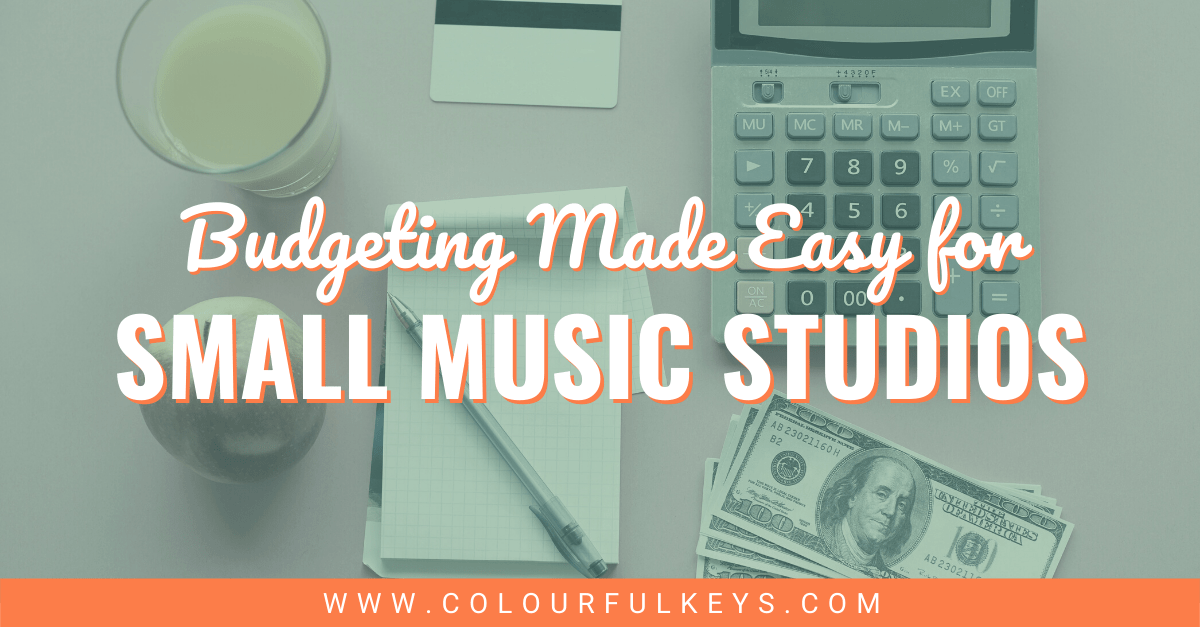
This article about budgets for small music teaching studios was written by Juanita Stauffer. Juanita teaches piano in Edmonton, Alberta, Canada. She has an ARCT from the Royal Conservatory of Canada and has been teaching for over 20 years. She also enjoys playing cello in a community orchestra, reading, knitting and gardening.
Do you ever wonder where your money goes? As a self-employed teacher, it can be hard to figure out how much you are actually taking home – and it’s easy for the money to trickle away. Budgeting can get a bad rap, but it’s just a way to figure out what you have and where it should go.

One of the biggest benefits in my career as a music teacher has been flexibility. I’ve been able to take time off when my children were young and add students as my available time increased.
But as a small business owner, I don’t get handed a paycheck every month. Instead, I have to figure out how to manage the money which comes in – both to pay myself and to invest in my business.
This can be difficult for any music teacher, regardless of the size of the business. But it can be especially important for those teachers with small studios, because there’s not as much money to go around.
What counts as a small studio?
In the 2021 Vibrant Music Teaching Industry Report, just over 30% of teachers had fewer than 15 students. About 38% had 16–30 students.
For the purposes of this article, we’re going to consider a small studio as around 20 students or fewer. Of course, the actual time spent teaching can vary depending on how long the lessons are and if you have any buddy or group lessons, but generally this means that teachers spend 7–15 hours per week actually teaching (not counting admin or lesson planning time.)
64% of the teachers in the survey for the report were from North America with another 20% from the UK and Australia, and the rest from other parts of the world.
In any of those areas, it’s unlikely that you’re able to support yourself entirely with a small studio, so you may have another job with piano teaching being your second income. Or you have a partner who contributes to the household earnings.

Subscribe to the newsletter and get the 2021 Vibrant Music Teaching Industry Report
Enter your details to subscribe to the newsletter for piano teachers with information, tips and offers.
I hate spam as much as you do! I will only send you emails related directly to piano teaching and you can unsubscribe at any time.
If you’re supporting yourself on your own income, kudos to you and you probably don’t need to keep reading. 🤭
How to Plan for Expenses
So where do you start?
As Maria says in ‘The Sound of Music’, “Let’s start at the very beginning…”
Step 1: How much do you make?
This is usually an easy number to come up with, especially if you have a set monthly fee. Look at your list of students and figure out how much you make each month. Or if you don’t have a set fee, look back at your records and add up all of the income you brought in last year.
Step 2: How much do you spend?
Second, you need to know how much you spent on your business in the past year. I hope that you already keep good records for your taxes; but if not, this is the time to start.
If you aren’t sure what you spent in the last year, start with your tax return or your accounting program (QuickBooks, My Music Staff etc.) Look at the categories you already have. If you don’t have categories already, divide up your expenses now.
Here are some categories to consider:
- Yearly expenses: taxes, maintenance of piano, associations, business taxes, conferences, online forums, accounting, charitable giving
- Two to three times per year: studio supplies, music
- Monthly: subscriptions, smaller studio supplies, music
If you don’t already have a separate bank account for your business, I suggest that you set one up. It doesn’t have to be a full business account but it will be much simpler to track your income and expenses if it’s separate from your household accounts.
Make the Most of a Smaller Budget
Now that you have your income and expenses, compare them. Have you been paying yourself a salary? If not, why not? Is it because you’ve been spending so much on studio expenses that you have nothing left?
Dividing Up your Income
Consider how you could divide up your income. I came across a formula last year which suggested small businesses like ours set aside 50% for salary, 5% for profit, 30% for operating expenses and 15% for taxes (depending on your country’s taxes.)

You can tweak the numbers to reflect your own situation, but it’s a good starting point. If you’ve been spending 75% on expenses, consider rethinking how you allocate your funds.
Pay Yourself First
This is why you need a separate bank account. After you’ve received your monthly payments from families, look at your budget and send your salary to your household account.
If you only collect income for 9 or 10 months of the year, you’ll also need to decide how to pay yourself for the whole year. You can set aside a portion each month, or ask the parents to pay less per month and instead spread it over 12 months. Or decide that you are okay with just having income for 9 or 10 months.
Plan ahead so that you know how you’ll handle time off. Do what works for you.
Know Your Priorities
Now it’s time to look at your expenses. It’s a good idea to review your expenses and see if there’s any place where you can save money.
What’s really important?
An expense might only be $20 or $30 dollars per month. But that can add up! If you are paying for a subscription to an online forum which you never have time to look at, that’s not a good use of your resources.
I get a lot of emails with opportunities to buy things, or I’ll watch a webinar where they offer 30% off their new product.
If you really know yourself, your studio priorities and your budget, you won’t be as tempted to buy every new thing which comes along.
Try to Get the Most Bang for your Buck
Think about your categories of expenses and decide what helps you and your students most. Here are a few examples.
Professional Development
Are the webinars or conferences helping you to become a better teacher? Do you have time to watch 5 webinars in a month?
Studio Supplies and Subscriptions
Do you love the music you get in a monthly subscription but your students don’t like the pieces? Decide if that’s worthwhile to you. Are you using the resources you already have or are you just stockpiling?
Accounting
This is an area where every teacher must make their own choices. For example, I do my own taxes.

I know lots of teachers who use tax professionals; but for me, it’s always made more sense to do them myself (and ask questions of friendly professionals when needed.) I admit this can be a lot of work, but personally, it’s been worth it. If you would rather pay someone else, that’s a legitimate expense and you’ll have to cut back in another area.
You can learn more about budgeting and handling your business finances on Nicola’s Studio Business hub page.
Creating your Budget
Now it’s time to take all of that hard work you’ve put into analysing your expenses and put it into a money action plan: your budget.
Prioritise Relationships
As music teachers, we can feel very lonely in our industry. If you have the opportunity to spend time with other teachers, whether it’s locally or online, prioritise putting your money there.
Pssst…if you become a member of Vibrant Music Teaching, you’ll have instant access to community forums you can use as a sounding board, plus regular “huddles” where members gather in small groups online to talk about a particular subject. The community factor is one of the biggest benefits of a VMT membership!
Be Realistic
You may need to invest in some music for your music library so you become a more effective teacher. Figure out how to do that in a cost-effective manner, or just plan to spread out your expenses over several months.
For example: Instead of buying all three levels of the new beginner method you’ve decided to try with a student, why not just buy the first level? Then if you discover it’s not for you, you don’t have a lot of money invested in books which will gather dust on your shelf.
Don’t be Too Generous
Find a balance between being generous to your students and charging them for the items they are using.
I think teachers in general can be very generous and we feel bad for charging families for things we’re not sure they’ll see the value of.
There’s a time and place for lending out music. But don’t let your business finances go into the hole because you’re too nice to ask the parents to pay.
I find it especially challenging to figure out how to handle subscriptions. There are some good ideas on the internet about ways teachers have figured out to share the costs with their students, such as switching to an all-inclusive tuition fee structure.
If you think you are spending too much but you don’t know how to change it, do some research and ask other teachers how to handle the situation. You’ll probably find just the right answer for you.
Look your Expenses in the Eye
Finally, let’s examine your expenses. Look at your summary and make three lists:
- Essential expenses
- Nice-to-have expenses
- Unnecessary expenses

Remember that you are aiming to spend about 30% of your income on expenses, excluding taxes. If every expense ends up on the essential list and the percentage is over 30%, look again – are you sure they’re really all essential? If so, you’ll have to decide what to do about it. You can increase the percentage, but that means you have less for your salary.
So consider the expenses carefully and really decide if every single one is necessary. I suspect it’s not.
Pitfalls
There are a few things I’ve seen happen to small studio teachers again and again.
Falling Into the Comparison Trap
In this internet age, it’s easy to compare yourself with other teachers. If they find something essential, you may think it’s essential for you.
But it depends on your personality, your teaching style and your students. I’ve had teachers tell me about marvellous apps their students love, but they turned out to be complete duds for my students.
If you need to compare, do so carefully and tread lightly.
Not Knowing Where your Money Is Going
You can’t budget if you don’t know what you have and where it’s going. The number one rule of money management is to know what you have. Take the time today to start working on this.
Not Having a System for Tracking Your Expenses
Without a system, it will be very difficult to keep track of all your expenses. You need to have a system for accounting, and you also need to know how to keep track of your receipts. Nicola has a blog post of how she does it, complete with a Google Sheet template you can copy for yourself – this might be a good place for you to start.
Paying Unnecessary Fees
It’s so easy to overlook extra fees which can really eat up your income.
Can you reduce your bank account fees?
Hint: lots of institutions have no monthly fees. You’ll also need to decide how to handle fees for online payments and whether it’s worth it for your business to allow online payments because of the associated fees.
Is currency exchange taking a big bite out of your bank account?
When you look at the price of a subscription, take note of what country’s currency they’re using. Because I’m in Canada, a USD$20 monthly subscription can actually cost over $30 per month, depending on the exchange. This might be worth it, but I need to think about it before signing up.
How do you plan and manage the budget for your small teaching studio?
Whatever your income level, I hope this has given you some ideas about how to budget and encouraged you to run your own business in a way which works for you and your family.
I’d love it if you could share your thoughts and ideas in the comments below. 🙂
